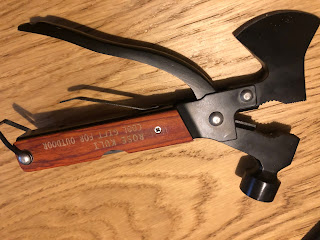Multitools have a special place in the heart of all preppers. They make for a resource rich bundle that can provide a lot pf utility in a small package. whilst the ubiquitous Swiss Army Knife is probably the first multi-tool for many ( it certainly was for me), the Leatherman or Gerber belt tool has taken the place in the eyes and EDC of many and whilst these paragons of utility assuredly have their place, they don't do everything. That's were something like the Rose Kuli hammer tool comes in.
Prominently featuring a split hatchet head and a hammer head, the jaws opening up to expose pliers and cutters, with a spring assist for the plier arm. The Rose Kuli tool features red wood scaled handles, screws recessed in at the high end and riveted at the bottom end, the plyer-arm retaining loop seats into a notch in the bottom of the plyer arm, preventing the plyer head from opening up unexpectedly.

 The hammer-head sits directly in line behind the hatchet head to maximize impact efficiency for both tools. I found that the small hatchet head being only 4cm (1 1/4") broad but was plenty enough tool to carve a notch in some logs i have seasoning at the back door. You wont be felling any mast logs with it, but it'll work nicely delimbing small logs, and even baton splitting, the hammer head providing a good strike face. I worried that the hatchet head appeared riveted in place and would come loose but it turns out that top rivet only holds the sides in place and the hammer/hatchet pieces were secured by the pivot rivet and marry up tightly when the plyer arm is closed.
The hammer-head sits directly in line behind the hatchet head to maximize impact efficiency for both tools. I found that the small hatchet head being only 4cm (1 1/4") broad but was plenty enough tool to carve a notch in some logs i have seasoning at the back door. You wont be felling any mast logs with it, but it'll work nicely delimbing small logs, and even baton splitting, the hammer head providing a good strike face. I worried that the hatchet head appeared riveted in place and would come loose but it turns out that top rivet only holds the sides in place and the hammer/hatchet pieces were secured by the pivot rivet and marry up tightly when the plyer arm is closed.
The plyer jaws have both a fine toothed and a broad toothed section, for both fine and coarse tasks as well as a 1cm (2/5") cutting jaw, for wire or nail cuttings.
The hammer itself drives nails quite well, for such a light tool at 400g (14oz), and I could tap one into my new treated-pine fence-posts with ease. The wood scales and plyer arm make for a comfortable grip on the palm and fingers. the hammer-side handle-face holds a surprise in the form of a selection of folded tools.There are 5 fold-out "blades" to further supplement the tools over-all utility. From left to right there is a simple leaf-point single edge blade, a Phillips head screw-driver, a wood-saw with fish-hook disgorger tip, a 4-size hex nut wrench (5,6,7,10mm) with bottle-opener and pry head, and a serrated blade with a file and flat-head driver tip. I would have liked a can-opener, and none of the tools lock, but each are functional.
As Corb Lund would sing "Well it's a vise grips for pliers, and pliers for a wrench
A wrench for a hammer, hammers everything else"It came in a flimsy nylon sheath with a hook and loop flap that barely covers the heads, leaving the edge of the hatchet somewhat exposed.
For a light-weight tool, it certainly bridges the gap between belt-multitool and camp-hatchet.
 The meal itself consists of freeze dried beef, rice and vegetables in a soy flavoured sauce. The meal is both Gluten free and had no added dairy, both good to know for those with dietary requirements like Coeliac's such as I have in my family. One thing I neglected to pay attention to was the full ingredient list and one of the vegitable components was dehydrated capsicum to which i'm allergic. Thankfully I was able to pick out even after re-hydration, with no ill effects. The squares of dehydrated beef reconstituted nicely as did the rice. The dish, once water is added, and left to stand for 10-15 minutes, and given a good stir ( right down to the corners of the retort), the meal thickened up into a very satisfying consistency. Easily spoonable without being sloppy, it was easy shared out.
The meal itself consists of freeze dried beef, rice and vegetables in a soy flavoured sauce. The meal is both Gluten free and had no added dairy, both good to know for those with dietary requirements like Coeliac's such as I have in my family. One thing I neglected to pay attention to was the full ingredient list and one of the vegitable components was dehydrated capsicum to which i'm allergic. Thankfully I was able to pick out even after re-hydration, with no ill effects. The squares of dehydrated beef reconstituted nicely as did the rice. The dish, once water is added, and left to stand for 10-15 minutes, and given a good stir ( right down to the corners of the retort), the meal thickened up into a very satisfying consistency. Easily spoonable without being sloppy, it was easy shared out. 




























